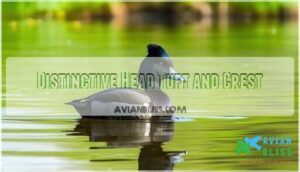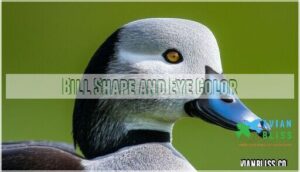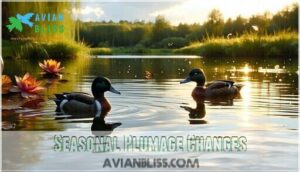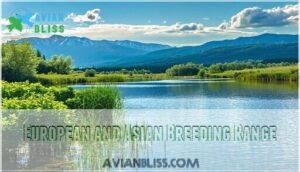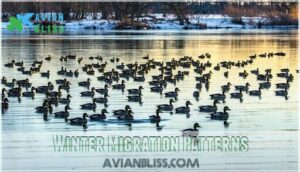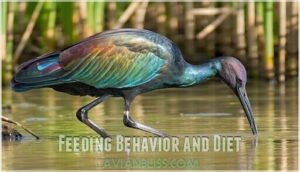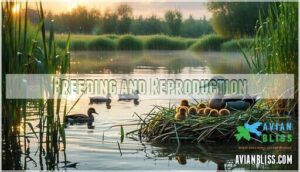This site is supported by our readers. We may earn a commission, at no cost to you, if you purchase through links.
 You’ll spot a tufted duck by its distinctive drooping head crest and striking appearance. Males showcase glossy black-and-white plumage with bright white flanks, while females wear chocolate-brown feathers for perfect camouflage.
You’ll spot a tufted duck by its distinctive drooping head crest and striking appearance. Males showcase glossy black-and-white plumage with bright white flanks, while females wear chocolate-brown feathers for perfect camouflage.
These 16-18 inch diving ducks inhabit freshwater lakes across Europe and Asia, plunging 1-4 meters deep to catch mollusks and crustaceans with their pale blue bills.
Their golden-yellow eyes and systematic hunting techniques make them fascinating waterfowl to observe. Understanding their seasonal behaviors and preferred feeding spots reveals the secrets behind successful tufted duck identification.
Table Of Contents
- Key Takeaways
- Tufted Duck Physical Characteristics
- Habitat and Geographic Distribution
- Feeding Behavior and Diet
- Breeding and Reproduction
- Conservation Status and Population Trends
- Frequently Asked Questions (FAQs)
- Where do tufted ducks live?
- Is a tufted duck rare?
- Are tufted ducks migratory?
- What is the behavior of a tufted duck?
- What is the typical lifespan of a Tufted Duck?
- How do Tufted Ducks adapt to urban environments?
- What are the primary predators of Tufted Ducks?
- Can Tufted Ducks be kept as domesticated pets safely?
- How do Tufted Ducks adapt to extreme weather conditions?
- Conclusion
Key Takeaways
- You’ll identify tufted ducks by their distinctive drooping head crest and contrasting plumage – males sport glossy black-and-white feathers while females wear chocolate-brown camouflage.
- You can spot them diving 1-4 meters deep in freshwater lakes across Europe and Asia, where they hunt mollusks and crustaceans with their pale blue bills and golden-yellow eyes.
- You’ll find these adaptable birds in urban park ponds and reservoirs, not just wild lakes, making them accessible for birdwatching in city environments.
- You can observe their peak feeding activity during early morning and late afternoon hours when they form large flocks and demonstrate their specialized underwater hunting techniques.
Tufted Duck Physical Characteristics
You’ll immediately notice the tufted duck’s striking black and white contrast if you’re looking at a male, while females display subtle brown tones with lighter flanks.
The species’ namesake drooping head crest becomes most prominent during breeding season.
These medium-sized diving ducks measure around 16-18 inches, with distinctively pale blue bills and bright golden-yellow eyes.
Male Vs Female Plumage Differences
You’ll spot tufted duck sex determination through dramatic plumage coloration differences. Males showcase striking black-and-white feather patterns with glossy dark heads, necks, and backs contrasting bright white flanks. These visual cues serve as powerful mating signals during breeding season.
Females display entirely chocolate-brown plumage throughout their bodies, creating a subdued appearance perfect for camouflage.
Distinctive Head Tuft and Crest
The tufted duck’s namesake crest sets it apart from other diving ducks. You’ll notice the male’s prominent black tuft drooping from his crown, while females sport a smaller, less conspicuous crest.
These tufted feathers aren’t just for show—they play roles in courtship displays and species recognition. The tuft’s size varies seasonally, becoming more pronounced during breeding season.
Feather maintenance keeps these distinctive head plumes in prime condition for identification purposes.
Size, Weight, and Body Proportions
Adult tufted ducks measure 16-19 inches in body length, with males slightly larger than females. Weight range spans 1.4-2.2 pounds, showing notable size variations between sexes and seasons.
Morphology studies reveal compact, rounded proportions typical of diving ducks. Unlike the elongated tufted puffin, these waterfowl display stocky builds optimized for underwater foraging. Their tuft adds visual height without affecting overall body measurements.
Bill Shape and Eye Color
Beyond overall body size, you’ll want to examine the beak structure closely. The bill is blue-grey with a black tip, giving it a two-toned appearance that’s distinctive among diving ducks. Both males and females display bright golden yellow eyes year-round.
This eye pigmentation provides excellent visual acuity for underwater hunting. The bill coloration remains consistent across seasons, unlike the tufted puffin’s seasonal changes. These iris patterns help distinguish tufted ducks from similar species at distance.
Seasonal Plumage Changes
Throughout the year, you’ll notice dramatic plumage coloration shifts as tufted ducks undergo feather molting cycles. Males transform from striking black-and-white breeding displays to subdued eclipse plumage during summer molt, providing seasonal camouflage while flightless.
- Watch breeding males lose their glossy black heads temporarily
- Notice how migratory adaptations include duller winter feathers
- Observe females maintaining consistent brown tones year-round
- Spot the distinctive tuft shrinking during non-breeding seasons
Habitat and Geographic Distribution
You’ll find tufted ducks across freshwater lakes, ponds, and slow rivers throughout Europe and Asia. Some populations migrate to coastal waters during winter months.
These adaptable diving ducks also frequent urban park ponds and reservoirs, though they’re rare visitors to North American waters.
Freshwater Lakes and Ponds
When you’re searching for tufted ducks, focus on freshwater lakes and ponds with rich aquatic plants. These water bodies provide ideal lake ecosystems where tufts of vegetation create perfect habitat.
Pond management that maintains water quality fosters diverse freshwater ecology. You’ll spot these diving ducks in calm waters surrounded by tufted grass and tufted loosestrife, where abundant mollusks thrive beneath the surface.
European and Asian Breeding Range
You’ll find this tufted duck’s breeding grounds stretch like a vast feathered empire across Eurasia. Its breeding range extends from Iceland to Mongolia and Kamchatka in the Russian east, creating one of nature’s most impressive geographic distributions:
- Iceland to eastern Siberia – Complete continental coverage
- British Isles through Scandinavia – Northern European strongholds
- Central Asian breeding sites – Mongolia’s wetland nesting areas
- High-altitude nesting habitats – Up to 7,800 feet elevation
- Palearctic wetland systems – Freshwater lake preferences throughout
Winter Migration Patterns
You’ll witness notable migration routes as tufted ducks follow northeast-southwest flyways each autumn. These birds form massive flocks numbering thousands, creating impressive rafts on wintering waters from October through November.
Weather adaptation drives their timing, while stopover sites provide vital refueling opportunities. Flyway conservation efforts protect these corridors, ensuring flock dynamics remain stable across their extensive migratory journey.
The tufted duck’s behavior is characterized by its ability to thrive in various environments, including those with diving duck habits.
Urban Park Waters and Reservoirs
You’ll spot tufted ducks thriving in urban park waters and reservoirs across cities. These adaptable birds embrace artificial aquatic features, from ornamental ponds to water treatment facilities.
Park ecosystems provide reliable food sources and shelter, while reservoir management creates ideal diving conditions. Urban wildlife like tufted ducks demonstrates notable resilience, with their distinctive tuft helping identify them among city waterfowl.
Water quality improvements benefit these diving specialists substantially.
Rare North American Sightings
Occasionally, tufted duck vagrants reach North America, with records from 30 U.S. states and all 10 Canadian provinces. These wandering ducks appear in different ways:
- Single birds mixed among scaup flocks during winter
- Migration patterns following Atlantic and Pacific coastal routes
- Birding tours documenting habitat use near reservoirs
They’re reaching the northeast from Europe and Iceland, and reaching Alaska and the Pacific Coast from Asia. Species tracking shows sighting reports increasing. The tufted duck’s diving duck habits play a vital role in its ability to thrive in various aquatic environments.
Feeding Behavior and Diet
You’ll observe tufted ducks employing specialized diving techniques to reach depths of 1-4 meters, where they systematically hunt mollusks, crustaceans, and aquatic invertebrates along muddy lake bottoms.
These adaptable feeders also consume plant matter and seeds, with peak foraging activity occurring during early morning and late afternoon hours when competition with other diving duck species remains minimal.
Diving Techniques and Depths
You’ll watch tufted ducks execute feeding dives with exceptional precision, reaching submersion depths of 3-14 feet below the surface. Their dive duration usually lasts 15-20 seconds as they navigate water pressure changes.
These ducks achieve dive speeds of 2-3 feet per second, using their compact bodies like a natural diving bell. The distinctive tuft helps optimize their head during underwater foraging missions.
Mollusks, Crustaceans, and Aquatic Invertebrates
Once tufted ducks reach the bottom, they target protein-rich prey that fuels their energy needs. These diving specialists consume zebra mussels, freshwater snails, amphipods, and chironomid larvae. Their bills perfectly grip slippery shellfish while filtering smaller invertebrates from sediment.
- Zebra mussels – Primary food source providing essential calcium for strong bones and eggshells
- Amphipods – Small crustaceans that boost protein intake during breeding season energy demands
- Chironomid larvae – Abundant midge larvae found in freshwater ecosystems year-round
- Aquatic worms – Nutrient-dense invertebrates supporting marine habitats food webs
- Freshwater snails – Calcium-rich mollusks vital for maintaining healthy shellfish ecology balance
Plant Matter and Seeds
Beyond their primary mollusk diet, you’ll find tufted ducks supplementing with aquatic vegetation and seeds. They consume pondweed shoots, algae, and floating seeds from tufted grass growing along shorelines.
This plant matter aids seed dispersal while providing essential carbohydrates. The birds’ foraging aids seed germination in new locations, creating beneficial plant adaptations that increase foliage density around their preferred shallow-water feeding zones.
Foraging Times and Patterns
Understanding food sources leads naturally to when you’ll spot these diving ducks at work. Tufted ducks follow predictable feeding cycles that help you time your observations.
Their foraging strategies vary by season and location:
- Peak activity occurs during dawn and dusk crepuscular periods
- Dive durations average 15-30 seconds for maximum forage efficiency
- Winter flocks concentrate feeding efforts around midday warmth
- Breeding pairs spread foraging throughout daylight hours
Competition With Other Diving Ducks
Foraging Competition
Breeding and Reproduction
You’ll observe Tufted Ducks begin their breeding cycle in late April when pairs establish territories on shallow freshwater lakes.
The female constructs her well-concealed nest near water’s edge, usually laying 8-11 buff-colored eggs that she’ll incubate for approximately 25 days.
Mating Season and Courtship Displays
Spring arrives and you’ll witness dramatic courtship rituals as male tufted ducks compete for attention. Their elaborate display behaviors showcase synchronized head movements, bill dipping, and aggressive posturing.
- Head-pumping displays occur repeatedly between males and females
- Males extend their necks upward while flicking their distinctive tufts
- Vigorous wing-flapping attracts potential mates during pair bonding
- Ritualized swimming patterns demonstrate fitness and breeding readiness
- Aggressive chasing eliminates competition and establishes mating hierarchies
These mating habits peak in late winter and early spring across European breeding grounds.
Nest Site Selection and Construction
Once courtship concludes, females begin the nest site selection process with notable precision. The female carefully selects a location near dense vegetation or under overhanging bushes. **Site selection prioritizes brood habitat near shallow waters with escape routes.
**
The female is primarily responsible for nest construction using available nest material. The egg chamber architecture resembles tufted fabric patterns, with natural materials creating a protective, cushioned structure.
Egg Laying and Clutch Size
Females begin laying their eggs about six days after selecting nesting sites. Clutch Size usually ranges from 8-11 greenish-grey eggs, though some tufted ducks produce clutches containing 6-14 eggs.
The female follows predictable laying patterns, depositing one egg daily in early morning hours. This systematic approach to egg formation ensures ideal timing for synchronous hatching later.
Incubation Period and Duckling Care
Life becomes a 28-day marathon for tufted duck mothers who rarely leave their nests during egg incubation.
Once the tufty ducklings hatch, they’re precocial—ready to follow mom immediately and find their own food. Duckling feeding happens quickly since these youngsters can dive within days.
Parental investment stays high as mothers provide nesting behavior protection and brood care until fledging.
Brood Parasitism and Nest Success
Tufted ducks face moderate brood parasitism rates, where females sneak eggs into neighboring nests. Research shows nest success drops slightly when parasitized with over six eggs, though brood reduction rarely occurs naturally.
You’ll notice nest defense strategies involve aggressive tufter behavior around their breeding territories. While tufted females rarely show egg rejection, they adapt their nesting strategies to minimize parasite intrusion.
Conservation Status and Population Trends
You’ll find that Tufted Duck populations remain stable across most of their range, though regional variations exist due to habitat changes and climate shifts.
Current monitoring programs track approximately 2-3 million breeding pairs worldwide, with numbers fluctuating based on wetland availability and seasonal conditions.
Current Population Numbers
Global numbers tell a promising story: you’ll find approximately 2.7 million tufted ducks worldwide according to current census methods. This stable population includes around 650,000 breeding pairs across Europe alone.
Global populations show approximately 2.7 million tufted ducks worldwide, with stable numbers offering hope for conservation efforts
Population trends show encouraging stability over recent decades, with conservation efforts maintaining steady numbers. Migration patterns help scientists track populations during surveys.
The UK hosts 18,000 breeding pairs that swell to over 100,000 birds in winter.
Habitat Loss and Degradation Threats
Beyond declining population numbers, you’ll find habitat fragmentation striking at the heart of tufted duck survival. Human encroachment destroys wetlands through development, while water pollution degrades their feeding grounds.
These ecosystem disruptions force ducks to abandon traditional breeding sites, creating a cascade of challenges for maintaining stable populations across their range.
Climate Change Impacts
As temperatures shift across Europe, you’ll notice tufted duck populations adapting to dramatic ecosystem disruption. Weather extremes threaten traditional breeding grounds, while sea level rise impacts coastal feeding areas. Their carbon footprint from altered migration patterns increases substantially.
Climate impacts reshape tufted duck survival:
- Earlier nest abandonment as extreme heat destroys eggs
- Starvation rates climbing when droughts eliminate food sources
- Chicks freezing during unseasonable cold snaps
Hunting Regulations and Protections
Regulatory frameworks protect you’ll find tufted ducks through hunting licenses, bag limits, and strict poaching laws across their European range. Wildlife refuges provide safe havens during hunting seasons, while conservation efforts maintain critical wetland habitats. These protections guarantee sustainable populations for future generations.
Monitoring and Research Programs
Scientists aren’t sitting on their hands in terms of tufted duck conservation efforts. Modern researchers rely on cell phone technology, banding programs, and movement tracking studies to monitor populations. You’ll find these research methods making waves:
- Species tracking through satellite telemetry and GPS devices
- Habitat monitoring using remote sensing technology
- Data analysis of breeding success and migration patterns
- Conservation efforts integrating wetland restoration projects
Frequently Asked Questions (FAQs)
Where do tufted ducks live?
You’ll find these diving waterfowl throughout temperate and northern Eurasia. They occasionally visit North America’s coasts in winter. They breed on shallow freshwater lakes, slow rivers, and park ponds.
Is a tufted duck rare?
No, you won’t usually find this species on rare bird lists. Tufted ducks maintain a healthy population of nearly one million birds across northern Eurasia.
They’re classified as Green under the UK’s Birds of Conservation Concern, meaning they’re not currently at risk.
Are tufted ducks migratory?
Ironically, birds known for staying put actually love to travel. These ducks are migratory in most of their range, and overwinter in the milder south and west of Europe, southern Asia.
You’ll spot them forming massive winter flocks after their seasonal journeys.
What is the behavior of a tufted duck?
You’ll spot these birds acting like aquatic acrobats, diving gracefully underwater for food. They’re highly social creatures that form large flocks, especially during winter months, chatting through various vocal calls.
What is the typical lifespan of a Tufted Duck?
Like a timekeeper measuring precious moments, you’ll find their average lifespan spans 8-10 years in wild conditions.
Some outstanding individuals can reach up to 24 years with ideal habitat and protection available.
How do Tufted Ducks adapt to urban environments?
You’ll notice urban adaptations when these diving ducks utilize park ponds and city water features. They’re becoming less fearful of human activity, adjusting feeding schedules around foot traffic, and exploiting supplemental food sources while maintaining their natural mollusk-diving behaviors.
What are the primary predators of Tufted Ducks?
Survival isn’t just about speed—you’ll find hawks, foxes, raccoons, and snapping turtles hunting these vulnerable diving ducks.
They can also be hunted by large birds of prey such as hawks, as well as terrestrial predators including foxes, raccoons, and common snapping turtles.
Can Tufted Ducks be kept as domesticated pets safely?
You can’t keep these wild waterfowl as pets. You won’t be issued a permit for keeping a wild animal as a pet, and they need specialized aquatic habitats.
These diving ducks require permits even for captive-bred birds in most states.
How do Tufted Ducks adapt to extreme weather conditions?
These feathered ice-breakers become nature’s thermostat experts during harsh conditions. Tufted ducks hunker down to conserve energy until the weather moderates. They alternately lift their feet to tuck them into their feathers for warmth retention.
Conclusion
Like a feathered jewel adorning quiet waters, the tufted duck remains one of Europe’s most recognizable diving ducks. Their systematic diving behavior and preference for deeper freshwater habitats distinguish them from surface-feeding ducks.
You’ll find success identifying this species by focusing on the male’s distinctive drooping crest and bold black-and-white contrast, or the female’s subtle brown tones.
Whether you’re observing their courtship displays in spring or watching winter flocks gather on urban reservoirs, the tufted duck’s unique characteristics make field identification straightforward with practice.
- https://www.allaboutbirds.org/guide/Tufted_Duck/lifehistory
- http://migrationatlas.org/node/1767
- https://esj-journals.onlinelibrary.wiley.com/doi/abs/10.1046/j.1440-1703.1999.00308.x
- https://www.nicolas-stettler.ch/en/birds-of-switzerland/tufted-duck
- https://www.ducks.org/conservation/waterfowl-surveys/2025-duck-numbers


